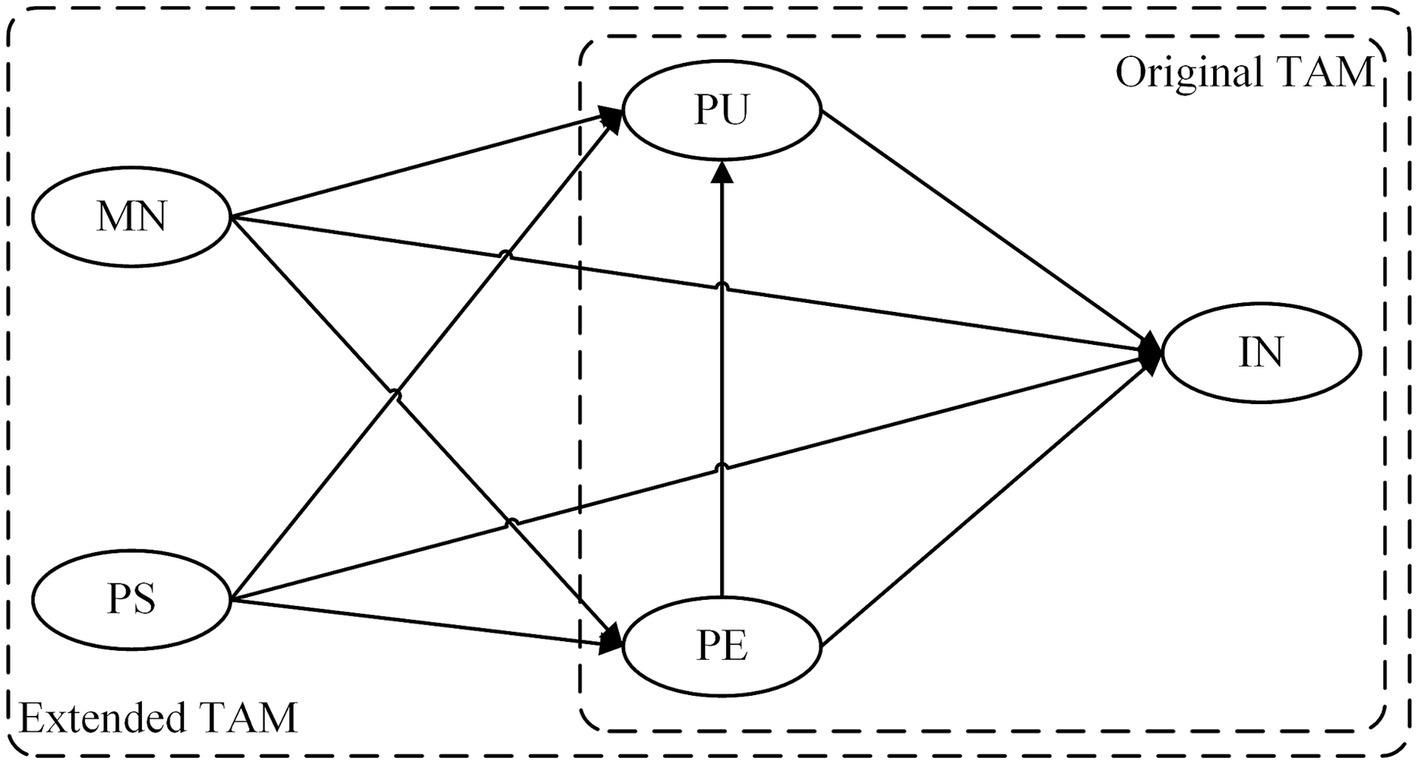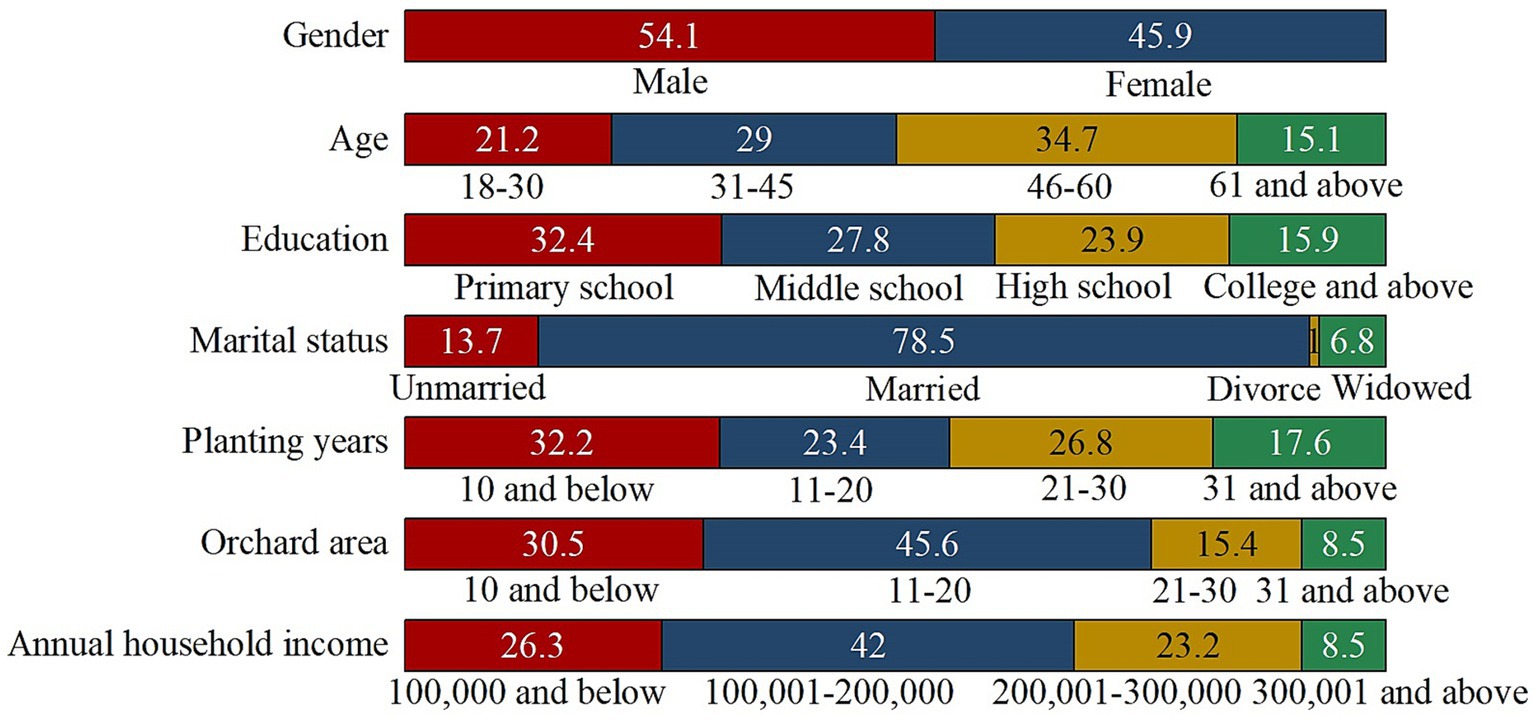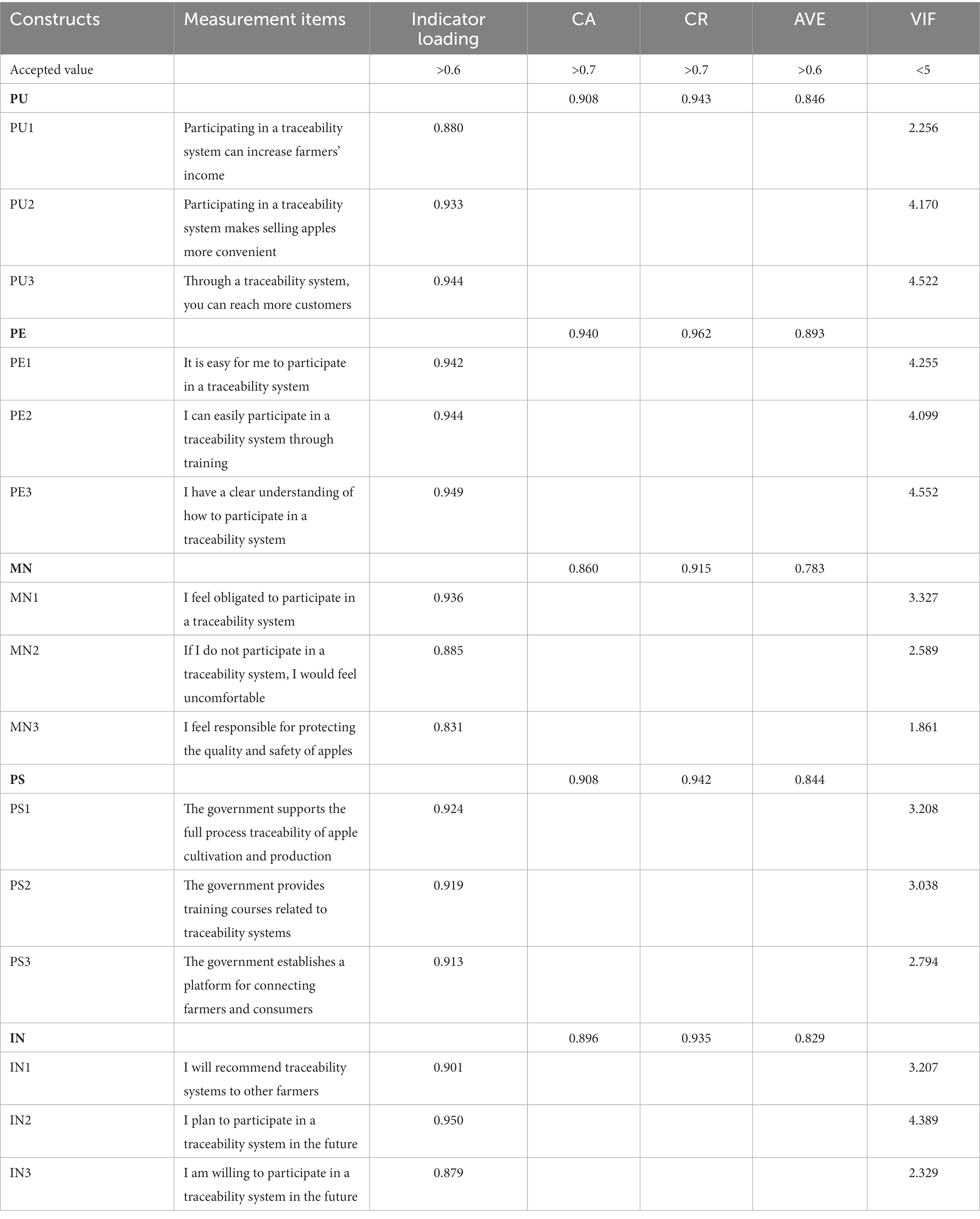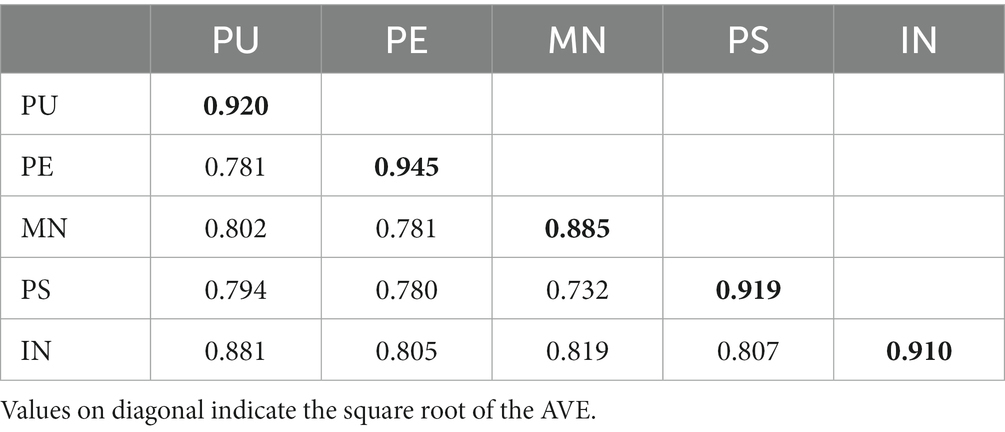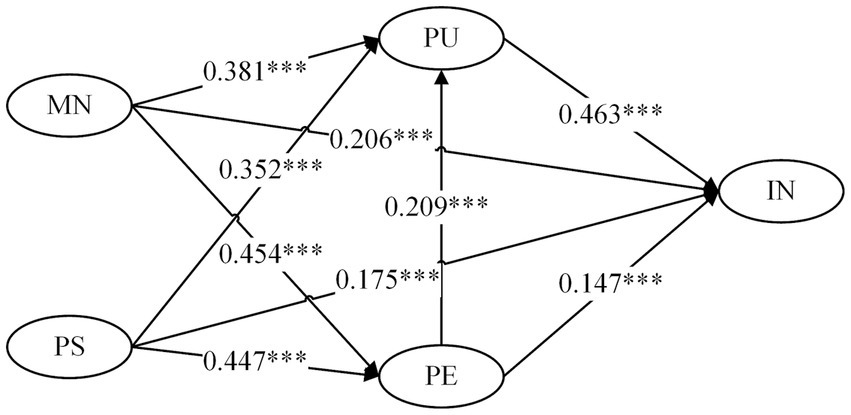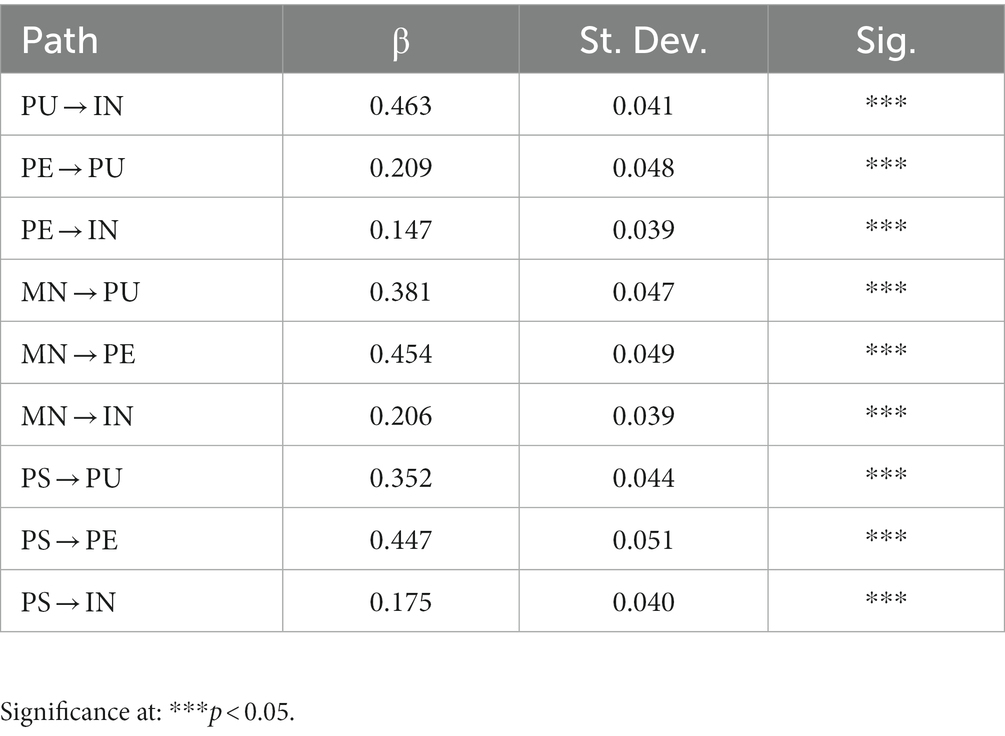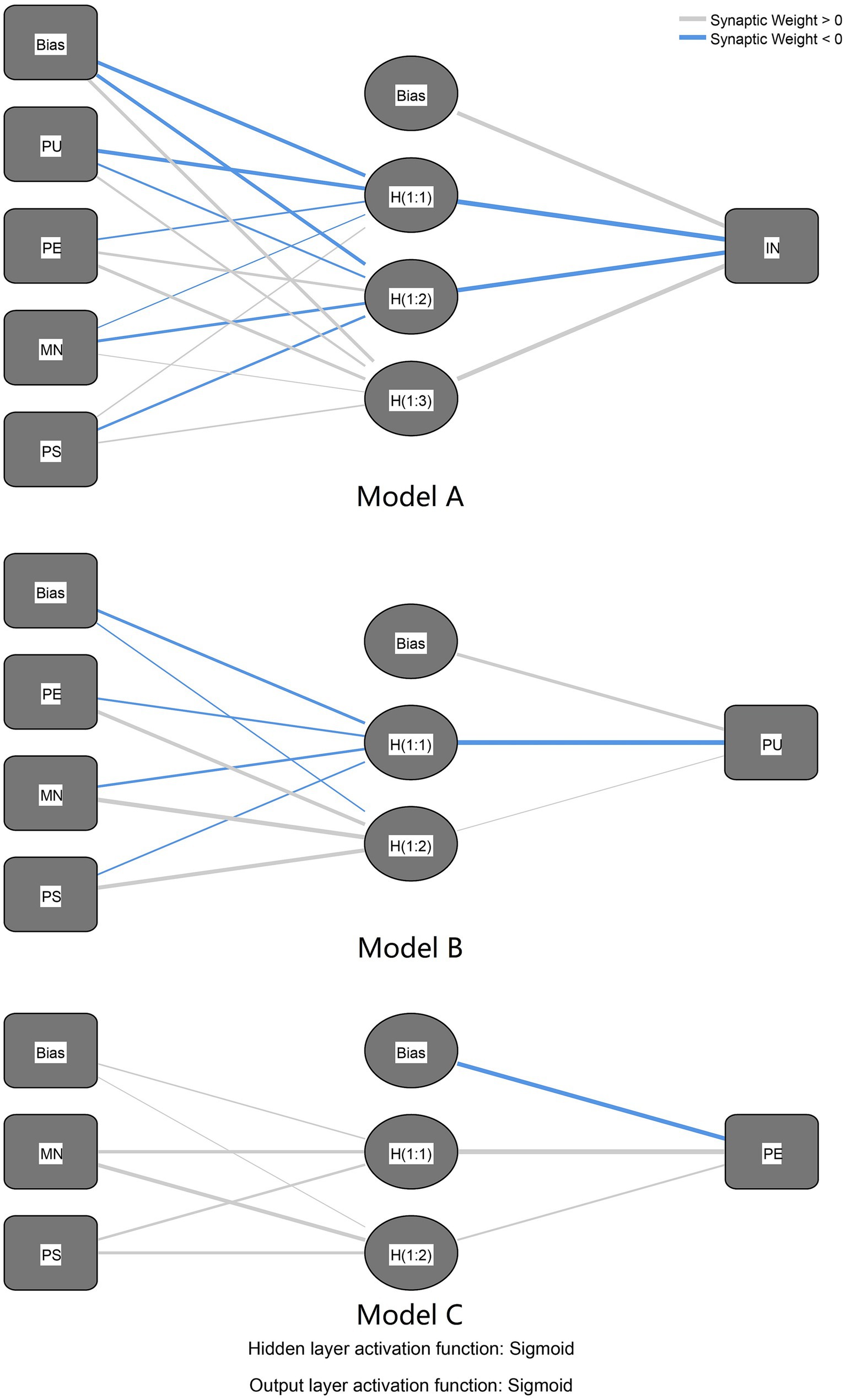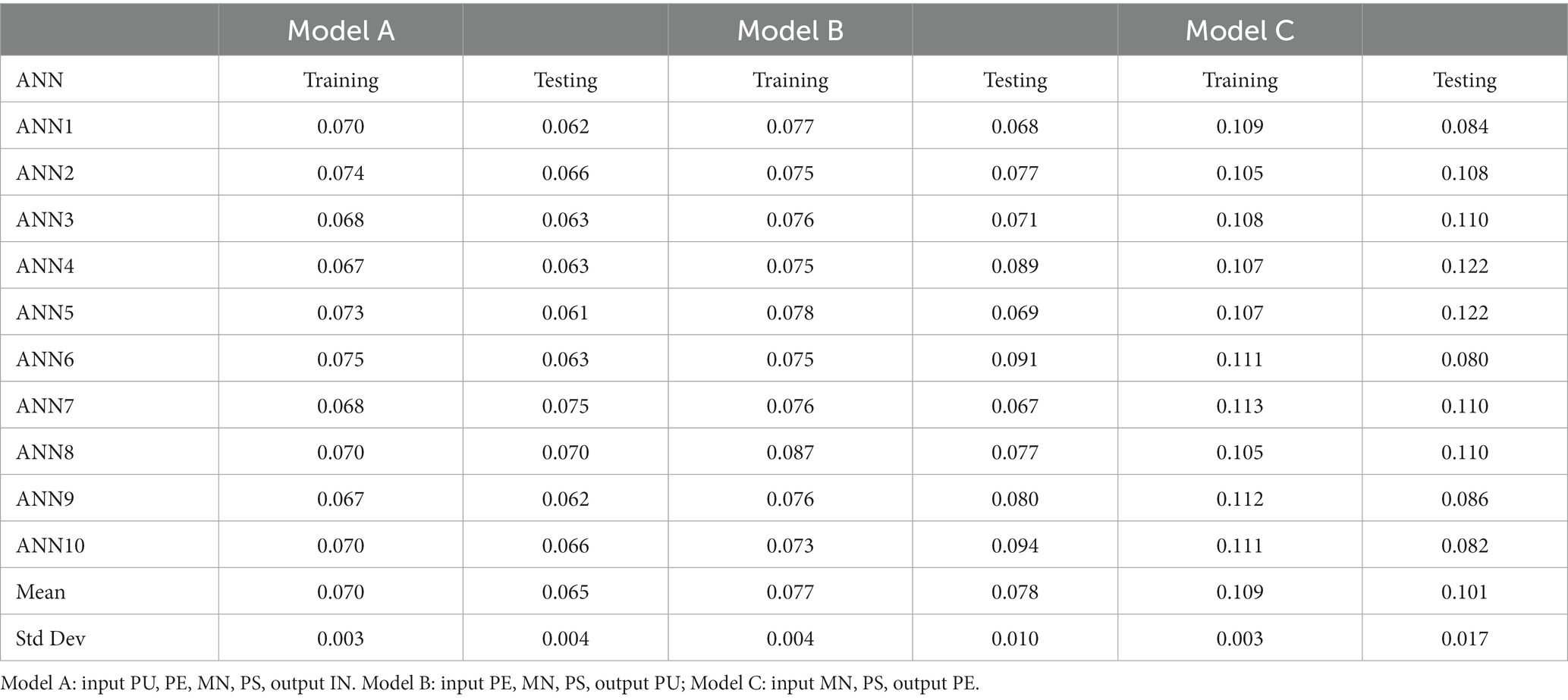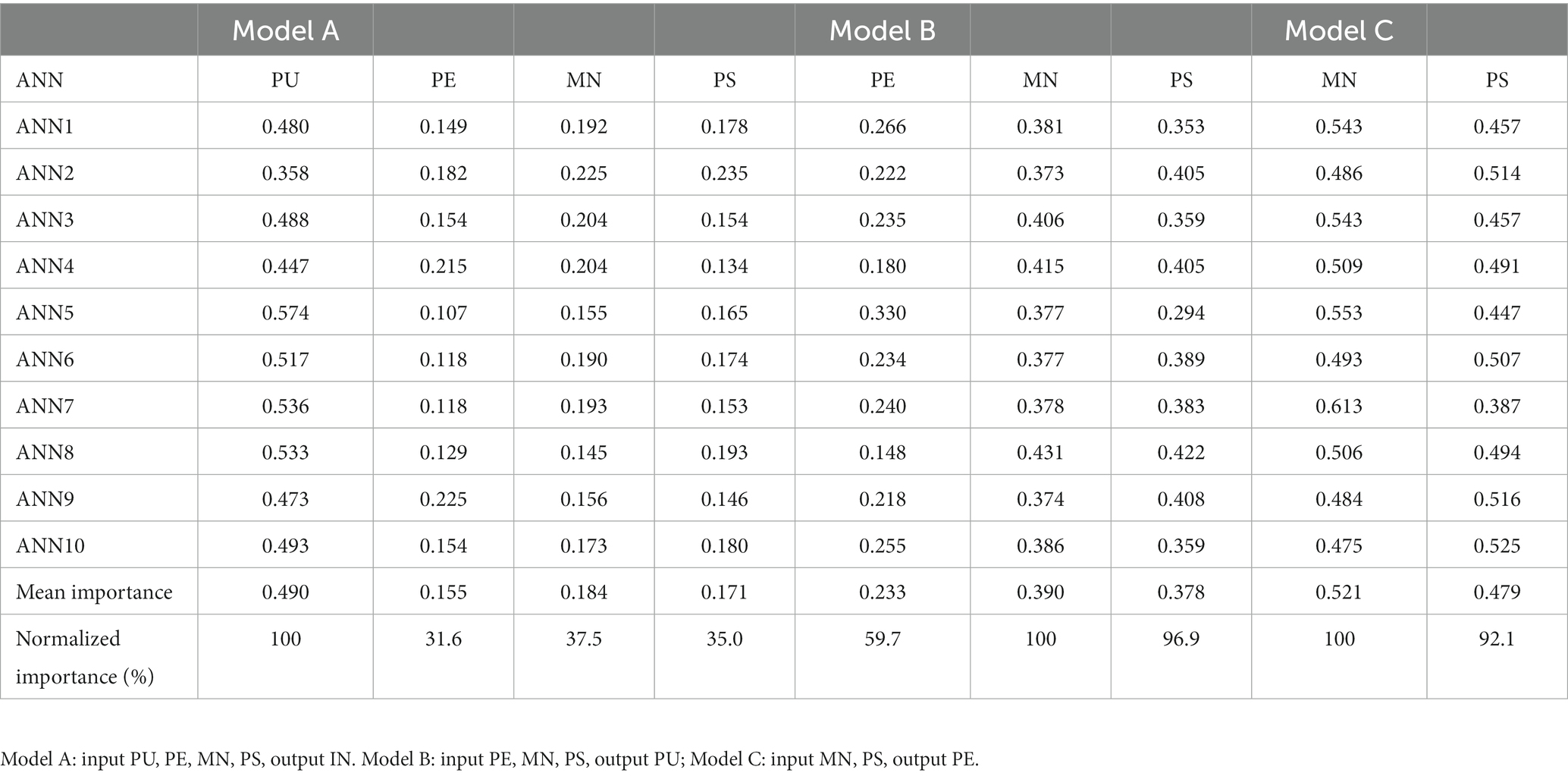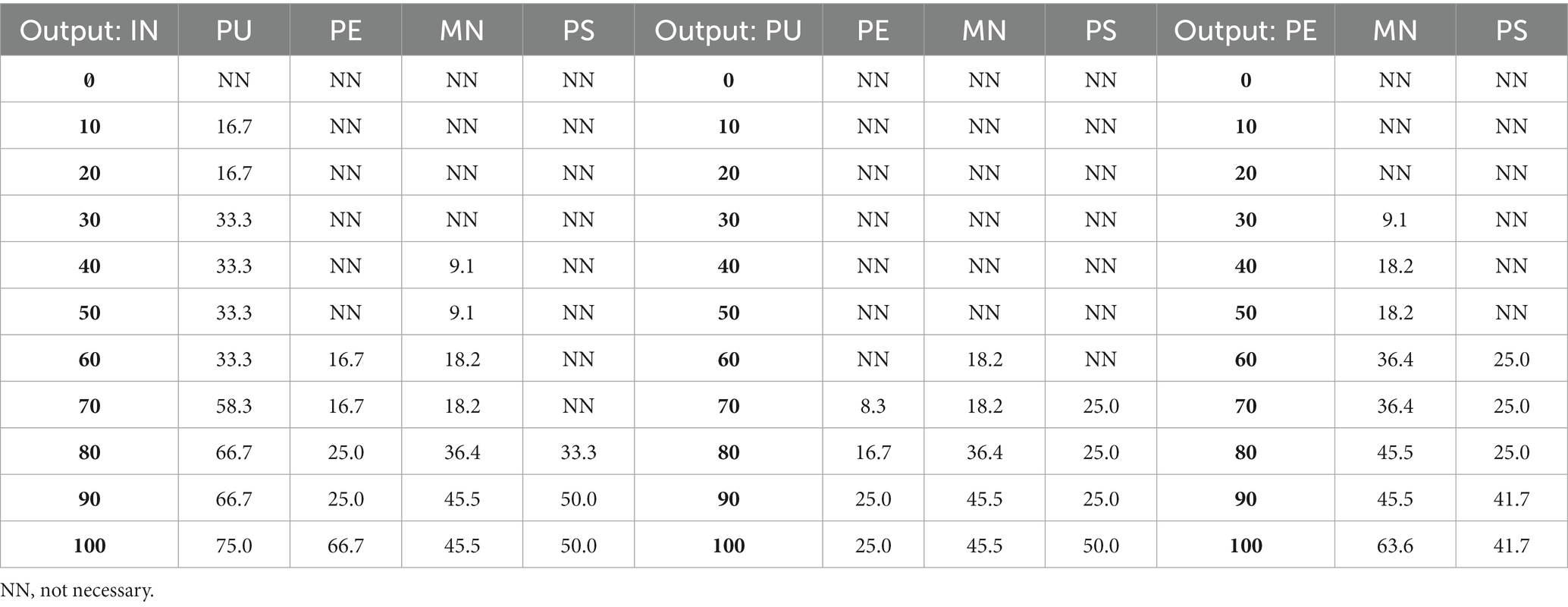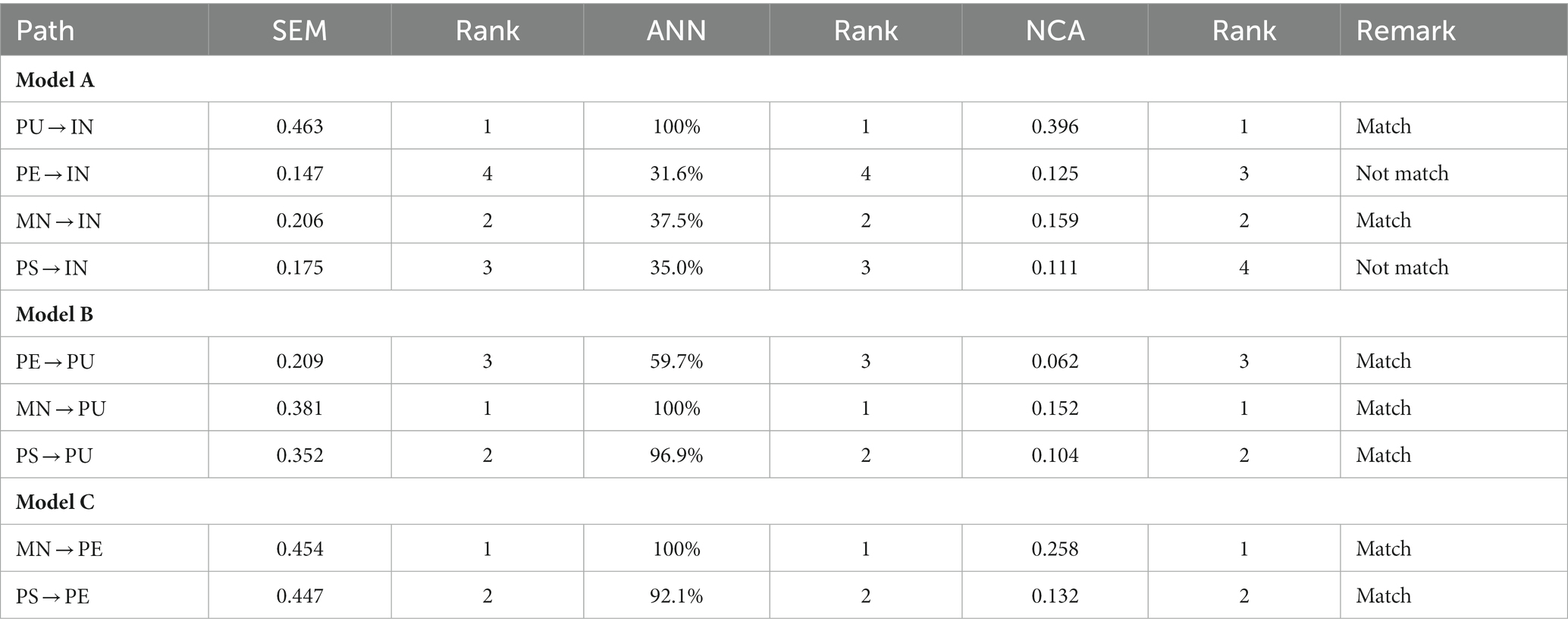- College of Economics & Management, South China Agricultural University, Guangzhou, China
Introduction: As a crucial technological tool for ensuring the quality and safety of agricultural products, the traceability system is of great importance in the agricultural sector. However, farmers’ participation in the system, especially among small-scale farmers, remains relatively low.
Methods: This study investigates the factors that influence farmers’ intentions to participate in traceability systems by integrating moral norms and policy support into the technology acceptance model (TAM) and using a three-stage approach of structural equation modeling (SEM), artificial neural network (ANN), and necessary condition analysis (NCA).
Results: The findings indicated that farmers’ intentions were primarily influenced by perceived usefulness. Perceived usefulness and perceived ease of use were strongly affected by moral norms and policy support. To promote farmers’ intentions, it is necessary to achieve at least 75, 66.7, 45.5, and 50% of perceived usefulness, perceived ease of use, moral norms, and policy support, respectively.
Discussion: These findings provide valuable guidance to government agencies and technology developers in prioritizing adoption strategies. This study not only expands the scope of TAM research, but also represents an early application of a three-stage approach to agricultural technology adoption research.
1 Introduction
Food safety is a fundamental prerequisite for attaining a better quality of life and improved nutrition (FAO, 2023). Unsafe food not only poses a threat to the health of consumers, but also contributes to food loss and waste. Ensuring food safety is, therefore, a vital condition for achieving the Sustainable Development Goals (SDGs). Research has highlighted that an efficient traceability system can meet the requirements of relevant institutions and provide consumers with essential product information, thereby enhancing both food safety and consumer confidence (Mehannaoui et al., 2022). By leveraging innovative technologies such as agricultural Internet of Things and blockchain, traceability systems can comprehensively track the entire journey of agricultural products from farm to table, providing consumers with detailed information (Feng et al., 2020; Xu et al., 2022). Consequently, the promotion of traceability systems is emerging as an important measure to improve food safety standards.
As a major producer and consumer of agricultural products, China faces significant challenges concerning the quality and safety of its agricultural products, such as food adulteration, foodborne diseases, and agricultural pollution (Zhang et al., 2023). The key to ensuring the safety of agricultural products is to raise awareness and promote active commitment to food safety among all stakeholders throughout the entire food supply chain (FAO, 2023). Consumers are willing to pay a premium for traceable agricultural products that provide detailed information (Jin et al., 2017; Liu et al., 2019). Agricultural enterprises are also proactively implementing traceability systems to ensure the traceability of their products (Qian et al., 2020). In China, ordinary and small-scale farmers, who play an important role in primary agricultural production, have limited participation in traceability systems and are not involved in traceability management.
Although traceability systems have significant potential for application in China’s agricultural sector, they still face challenges in terms of technology adoption. These challenges include high costs, lack of uniform market standards, insufficient technical personnel, and limited government support (Zhang et al., 2010). The majority of farmers in China are small-scale farmers, facing high cultivation risks, which hinders their participation in traceability systems (Huang et al., 2022). International public policies, such as the Food Safety 10-Year Plan (FAO, 2023) and the SDGs (UN, 2015), are collectively working for achieving food safety goals in the agricultural sector. However, these goals may be difficult to achieve if farmers’ intentions are not properly understood. Research has shown that the adoption of agricultural technology depends on farmers’ perceived capacity and social factors (Yang et al., 2022; Li et al., 2023). Moreover, models of agricultural technology diffusion also influence farmers’ technology adoption to some extent (Gao et al., 2020).
Although there has been positive progress in the research field of farmers’ participation in traceability systems, the existing studies have certain limitations. Liao et al. (2011) and Xu et al. (2012) examined the determinants of farmers’ participation in the food traceability system, however, they lack an analysis of farmers’ subjective psychology. In contrast, Li et al. (2021), while considering the subjective characteristics of farmers, overlooked important perceptual characteristics such as moral norms and policy support (Li et al., 2023). In addition, existing research fails to accurately predict the outcomes that influence farmers’ intentions to participate in traceability systems and identify the necessary conditions.
We have selected apple farmers in Sanmenxia City, Henan Province, located in central China, as the subjects of our research for several important reasons. Firstly, this region is located in the eastern part of the high quality fruit production zone on the Loess Plateau, which is characterized by significant day-night temperature variations and unique climatic conditions that are conducive to agriculture. These climatic factors positively impact fruit growth, granting the region a competitive advantage in terms of fruit quality. Secondly, despite the high quality fruit produced in this area, it is mainly cultivated by small-scale farmers who face challenges in realizing prices for their premium agricultural products. Research has indicated that Chinese consumers are inclined to purchase traceable apples, especially those grown in their country of origin (Liu et al., 2020), and are willing to pay an additional premium of over 40% for these apples (Jin et al., 2017). To some extent, this reflects the potential for increased economic benefits for farmers through participation in traceability systems. Although the agricultural sector in this area has developed a traceability system, the majority of farmers have not yet participated in it, highlighting the difficulties in promoting traceability systems at the grassroots level. Finally, in 2019, apples from this region received national recognition as geographical indication agricultural products. According to regulations on the quality and safety of agricultural products, they must adhere to strict management practices. This legal requirement provides a clear policy background, making this region an excellent case study for examining farmer participation in traceability systems.
To bridge the gap between literature and reality, this study makes significant contributions to the research field of farmers’ participation in traceability systems. It extends the technology acceptance model by introducing moral norms and policy support as key factors influencing farmers’ intentions to participate in traceability systems. Through the analysis of a structural equation modeling, the impact of these factors on farmers’ decision making has been examined. To improve the accuracy of the prediction results, artificial neural network to further strengthen the predictive and explanatory capabilities of farmers’ intentions was applied. Finally, by using the necessary condition analysis, we can determine which factors are necessary conditions for farmers’ intentions to participate in traceability systems.
2 Research model
The Technology Acceptance Model (TAM), introduced by Davis (1989), derives from the diffusion of innovation theory pioneered by Rogers (2003). This model translates concepts such as relative advantage and complexity into perceived usefulness and perceived ease of use. TAM further incorporates insights from the Theory of Reasoned Action (TRA) (Fishbein and Ajzen, 1977) and the Theory of Planned Behavior (TPB) (Ajzen, 1991). TRA and TPB are broad theories in behavior research, and TAM extends them to explain how individuals adopt various technologies.
2.1 TAM
In recent years, TAM and its extended forms have found wide applications in analyzing the acceptance and factors associated with agricultural technologies, providing deeper insights into farmers’ attitudes and behavioral intentions toward various agricultural technologies (Caffaro et al., 2020; Thomas et al., 2023). These studies have significantly contributed to enhancing the understanding of farmers’ acceptance of new technologies. The TAM consists of two main factors: perceived usefulness (PU) and perceived ease of use (PE) (Davis, 1989). In this study, we specifically examined farmers’ perceptions regarding the usefulness (PU) and ease of use (PE) of traceability systems. Previous research has confirmed the important role of PU in influencing farmers’ adoption of agricultural technologies (Caffaro et al., 2020; Li et al., 2021). In addition, the ease of use of these technologies is closely associated with farmers’ perceptions of their usefulness. Studies have indicated that when agricultural technologies are perceived as easy to use, farmers are more likely to recognize their practical value in agricultural production, which subsequently increases their intentions to adopt them (Diaz et al., 2021; Doanh et al., 2022; Ulhaq et al., 2022). These research findings further reinforce the important of PU and PE in shaping farmers’ intentions (IN) to adopt technologies.
2.2 Extension of the TAM
Despite the wide applicability of TAM in identifying and understanding various aspects of farmers’ behavior, several scholars have introduced additional variables into the original model to improve its stability, explanatory power, and predictive ability regarding farmers’ behavior (Caffaro et al., 2020; Rezaei et al., 2020; Doanh et al., 2022; Ulhaq et al., 2022). In fact, in addition to the factors inherent in the theory itself, TAM may include other significant variables that directly or indirectly influence intentions and behaviors. Therefore, based on supporting evidence from the literature, this study aims to extend the original TAM model with two additional variables (moral norms and policy support) to examine farmers’ intentions to participate in traceability systems. The theoretical model conceived for this study is illustrated in Figure 1.
Moral norms (MN) include expectations of moral obligations to perform or refrain from specific behaviors (Schwartz, 1977) and can also be understood as expectations of positive or negative consequences resulting from these behaviors (Savari et al., 2023). When it comes to farmers’ acceptance of agricultural technologies, MN play a crucial role (Gowda et al., 2021). Bozorgparvar et al. (2018) have confirmed that MN serve as the most influential predictor of farmers’ intentions to adopt renewable energy systems on their farms. Rezaei et al. (2018) argued that farmers’ engagement in food safety practices on their farms stems from their fundamental beliefs and moral values, which are driven by their sensitivity to their own well-being and the health of consumers. This sensitivity, in turn, leads to a stronger intention to participate in such practices. Furthermore, MN also contribute to an increased intention among farmers to responsibly use pesticides and fertilizers (Savari and Gharechaee, 2020; Ataei et al., 2021). Moreover, MN positively affects farmers’ perceived capabilities and the benefits associated with engaging in agricultural practices (Bagheri et al., 2019; Rezaei-Moghaddam et al., 2020; Gowda et al., 2021).
Policy support (PS) refers to the evaluation of government support perceived by farmers when participating in traceability systems. Government support can be manifested through resource redistribution, financial subsidies, market supervision and management, and increased external protection, among others. These forms of support can increase farmers’ self-efficacy, help them avoid risks, and further influence their behaviors (Li et al., 2023). In fact, government financial assistance and support from governmental institutions play a positive role in agricultural production, as robust infrastructure and financial support systems are crucial for minimizing income risks for small-scale farmers who are highly dependent on agricultural income (Li et al., 2018; Bhatt and John, 2023). Li et al. (2023) confirmed that government support is a significant variable in farmers’ willingness to engage in green planting technology. Zhang and Wu (2018) revealed that the government plays a unique role in the farmers’ innovation systems, facilitating collaboration between farmers and key external stakeholders to establish and maintain an innovation platform that allows for accessing and utilizing public or private resources and meeting the needs of small-scale farmers in agricultural production.
3 Methodology
3.1 Data collection
During the data collection process, we used two non-probability sampling methods: convenience sampling and purposive sampling. The samples we selected had to fulfill two essential criteria: involvement in the cultivation of geographical indication agricultural products (apple) and an age of 18 years or older. As recommended by Hashim (2010), the sample size should be at least 10 times the number of questionnaire items. To meet the minimum sample size required for empirical analysis, we distributed a total of 500 questionnaires and conducted face-to-face interviews with farmers aged 18 years and above. During the survey, farmers who were able to read and understand the questionnaire completed it independently. For those who could not read or write, we conducted interviews in the local language and recorded their responses to accurately fill out each question. After excluding key missing variables and invalid questionnaires, we obtained 410 valid responses, and the efficiency of the questionnaire reached 82%. The survey sample included different age groups, cultural backgrounds, economic conditions, and levels of participation in the traceability system, thereby providing a fundamental insight into their intentions to participate in traceability systems.
3.2 Questionnaire design
The survey questionnaire designed with standard procedures consisted of two main sections. The first section collected information on socio-economic characteristics of the respondents. The second section explored farmers’ intentions to participate in traceability systems and its influencing factors, including five latent variables (PU, PE, MN, PS, and IN) and 15 observed variables. While the introduction of more observed variables is expected to increase result reliability, following the guidance of Hair et al. (2014), it is recommended that each latent variable should include at least three observed variables to achieve favorable outcomes. In order to measure these observed variables, a 1–5 point Likert scale was used, indicating different levels of disagreement and agreement.
3.3 Data analysis
To enhance the scientific rigor and reliability of the data analysis, we used Smart-PLS software to analyze the structural equation modeling (SEM) and explore the causal relationships among variables. To address the limitations of linearity assumptions and oversimplification in the SEM, we used artificial neural networks (ANN) in the second step. For the ANN analysis, we used the feed-forward back-propagation multilayer perceptron technique. To minimize problems caused by overfitting, we used a 10-fold cross-validation technique, training the model on 90% of the data and testing it on the remaining 10%. We used SPSS 26 software to generate the hidden and output layers of the ANN model, and the activation function used was the sigmoid function. Finally, we performed necessary condition analysis (NCA) to identify the essential factors that influence farmers’ intentions. Since both SEM and ANN cannot establish the necessity of causal relationships, NCA plays a crucial role in identifying the factors that lead to specific outcomes only when necessary conditions are met (Dul, 2022a).
4 Results
4.1 Descriptive statistics
Figure 2 shows the demographic characteristics of the sample farmers. The results show that 54.1% of the respondents were male, while 45.9% were female. Almost half of the farmers were aged 46 years or older, and about one-third had received primary education. More than three-quarters of the farmers were married, and almost one-third had less than 10 years of planting experience. In addition, almost half of the farmers owned 11–20 mu (1 mu ≈ 0.07 hectares) of orchard area, and over one-quarter had an annual household income below 100,000 CNY.
4.2 SEM analysis
First, we use exploratory factor analysis to assess the factor structure of the observed variables. Within this process, we use both principal component analysis and the maximum variance method. To verify the partial correlations among variables, we use the Kaiser-Meyer-Olkin (KMO) statistic, a widely used measure of factor homogeneity. The KMO value falls ranges from 0 to 1, with a value over 0.8 indicating suitability for factor analysis (Tabachnick et al., 2013). In addition, we perform Bartlett’s test of sphericity to examine the intercorrelations among variables within the correlation matrix, with a p-value below 0.05 indicating statistical significance. The results indicate a KMO measurement of 0.9, which exceeds the recommended threshold of 0.8, and the Bartlett’s test of sphericity gives a highly significant result (p < 0.001). Moreover, the criterion for factor extraction is an eigenvalue greater than 1, the cumulative variance explained of 70%. Furthermore, all factor loadings for observed variables exceed 0.5, further confirming the validity of including each observed variable in the factor analysis.
Confirmatory factor analysis was also conducted to examine the reliability, convergent validity, and discriminant validity of the measurement model. The results indicated that both the Cronbach’s alpha (CA) and composite reliability (CR) values of the latent variables exceeded 0.7 (Table 1), indicating high internal consistency (Hair et al., 2010). Moreover, all measurement items had indicator loadings above 0.8, indicating high reliability. The average variance extracted (AVE) values of all latent variables were also greater than 0.7, indicating sufficient convergent validity. In addition, the variance inflation factor (VIF) values were all less than 5, indicating no significant collinearity problems in the model. Finally, the square root of the AVE values was greater than the corresponding correlation coefficients (Table 2), indicating good discriminant validity (Fornell and Larcker, 1981). In conclusion, the measurement model of this study has passed all tests and can be used for structural model analysis.
By comparing the standardized path coefficients, we analyzed the relative contributions of the predictor variables to the outcome variable. A larger standardized path coefficient indicates a stronger influence of that variable on IN. Figure 3 and Table 3 revealed that PU (β = 0.463), PE (β = 0.147), MN (β = 0.206), and PS (β = 0.175) had a significant positive direct effect on IN. Notably, PU had the most significant effect on IN. These four variables explained 83.6% of the variation in IN. In addition, PE (β = 0.209), MN (β = 0.381), and PS (β = 0.352) significantly influenced PU. Among these, MN had the most significant effect on PU. These three variables explained 74.9% of the variation in PU. Finally, MN (β = 0.454) and PS (β = 0.447) had a significant effect on PE. MN had the greatest effect on PE. These two variables explained 70.3% of the variation in PE.
4.3 ANN analysis
Figure 4 shows the ANN model, with model A ranking the importance of factors influencing farmers’ intentions, and models B and C ranking factors affecting PU and PE, respectively.
The root mean square error (RMSE) was used to evaluate the accuracy of the prediction results. Table 4 shows the training and testing process for each model. The results indicate that the average RMSE values were relatively low, ranging from 0.065 to 0.109, during both the training and testing processes, demonstrating that ANN has a good accuracy and fit effect for prediction.
We also conducted sensitivity analyses. Table 5 presents the results of the sensitivity analysis of the antecedents of IN (Model A), PU (Model B), and PE (Model C). In model A, PU (100.00%) was the most important predictive factor for IN, while the importance of PE, MN, and PS was relatively low, at 31.6, 37.5, and 35%, respectively. In model B, MN (100.00%) was the most prominent predictive factor for PU, followed by PS (96.9%) and PE (59.7%). In model C, MN (100%) was crucial for PE, followed by PS (92.1%).
4.4 NCA analysis
Necessary factors had to meet three criteria: theoretical plausibility, effect size (d) > 0, and p-value < 0.05 (Dul et al., 2020). Table 6 presents the results of the NCA. PU (d = 0.396), PE (d = 0.125), MN (d = 0.159), and PS (d = 0.111) were necessary conditions for IN. Among them, PU had a large effect, while the other three variables had medium effects. In addition, PE (d = 0.062), MN (d = 0.152), and PS (d = 0.104) were necessary conditions for PU. Among them, PE had a small effect, while MN and PS had medium effects. Furthermore, MN (d = 0.258) and PS (d = 0.132) were necessary conditions for PE, both with medium effects.
In order to explore the extent of the necessary factors required to achieve different results, we performed a bottleneck analysis. The first column in Table 7 represents IN, while the subsequent four columns represent the minimum values of the necessary factors (PU, PE, MN, and PS) required to achieve different levels of IN. Similarly, there are corresponding results for PU and PE. Specifically, to achieve 100% of IN, PU, PE, MN, and PS need to reach at least 75.0, 66.7, 45.5, and 50.0%, respectively. Similarly, to achieve 100% of PU, PE, MN, and PS need to reach at least 25.0, 45.5, and 50.0%, respectively. In addition, to achieve 100% of PE, MN, and PS need to reach at least 63.6 and 41.7%, respectively.
Table 8 presents the ranking and comparison of the important predictive factors in the research model. The ranking in SEM is based on path coefficients, while the ranking in ANN is based on normalized relative importance. In NCA, the ranking is based on effect sizes. It is clear that PU is the most influential and significant factor in influencing IN. In addition, PU and PE are significantly influenced by MN and PS. Overall, except for minor discrepancies in model A, the results are consistent across the other models, indicating the robustness of the research findings.
5 Discussions and implications
5.1 The main findings
Firstly, our research findings highlight that PU is the most crucial prerequisite and necessary factor influencing farmers’ intentions to participate. Typically, farmers, acting as rational decision makers, need to thoroughly assess the practical value of new technology before adopting it (Lou et al., 2021). When farmers perceive traceability systems as offering obvious benefits in the cultivation and sale of agricultural products, they are more likely to actively participate in the system, driven by their expectation of obtaining these benefits through participation. In our actual survey, we found that the majority of surveyed farmers generally believe that traceability systems help to increase their apple sales and raise the profile of apples, which in turn has a positive impact on their income. Therefore, policy makers should prioritize strengthening farmers’ perceptions of the usefulness of traceability systems in policy implementation to encourage their widespread adoption in the agricultural sector.
Secondly, the research highlights that MN is not only the most significant precursor and necessary factor for PU and PE, but also plays a central role in shaping farmers’ intentions. MN can, to some extent, transcend logic and cost-effectiveness (Maleksaeidi and Keshavarz, 2019), particularly in non-coercive behaviors. The MN have the potential to induce farmers’ feelings of pride or guilt, subsequently influencing their adoption of new agricultural technologies (Rezaei et al., 2018, 2019). When farmers perceive participation in traceability systems as a moral obligation, they are not only more likely to view the system as highly useful, but also more willing to overcome potential technological or operational challenges. This intention stems from their belief that it helps them to fulfill their moral obligations, even if it involves some learning and adaptation processes. However, it’s worth noting that MN are influenced by regional culture (Bozorgparvar et al., 2018; Faisal et al., 2020). In the socio-cultural context of rural China, farmers mainly adhere to altruistic principles, and their participation in traceability systems is primarily driven by ethical considerations, particularly their ethical responsibility for ensuring the safety of agricultural products. Therefore, strengthening tools and strategies based on MN emerges as one of the approaches to address issues related to farmers’ participation. It is advisable to foster farmers’ sense of moral responsibility during the initial stages of promoting their participation in traceability systems.
Finally, PS is a significant antecedent and a necessary factor influencing PU and PE. On the one hand, PS can increase farmers’ PU of traceability systems by providing financial incentives or subsidies. This provides farmers with security and reduces potential risks, enabling them to clearly see that participating in traceability systems will bring economic returns. On the other hand, government-sponsored technical training and resource support can improve farmers’ PE by reducing the technical complexity and operational barriers associated with participation in traceability systems. Previous research has also shown that robust government support can increase farmers’ technology acceptance and willingness by improving their psychological adaptability (Li et al., 2023; Thomas et al., 2023). In fact, the Chinese government has long played a central role in agricultural production, product quality, and safety, especially given the prevalence of small-scale farmers in China. Therefore, government agencies need to implement relevant support policies (Lou et al., 2021). In our actual survey, we found that only a very small number of farmers have the hardware and software systems required for participation in traceability systems, while the vast majority of farmers need policy support to participate in traceability systems. Therefore, improving policy support should become one of the crucial tasks for government agencies in the future.
5.2 Managerial implications
To promote farmers’ participation in traceability systems, the government and technology developers can use various strategies. One approach is to increase farmers’ awareness of the system’s advantages and functionalities through education and training. This includes helping farmers to understand consumers’ demands and requirements for agricultural product quality and safety, thereby stimulating their acceptance and intentions to participate in traceability systems. In addition, technology developers can simplify the system interface and provide training courses on hardware equipment and software systems to increase farmers’ understanding, confidence, and intention to participate. In addition, the government can strengthen social supervision to reinforce farmers’ moral norms and sense of responsibility. Finally, by improving relevant policies and regulations, the government can define the obligations and rights of farmers participating in traceability systems and provide support and incentives, such as establishing reward mechanisms and providing economic subsidies, to encourage active participation. These management insights have the potential to serve as valuable references for future policy making by government agencies and the promotion of traceability systems in the agricultural sector.
6 Conclusion
The perceived usefulness was the most crucial and essential factor influencing farmers’ intentions. Moral norms and policy support not only play an important and necessary role in perceived usefulness and perceived ease of use but also have a significant impact on farmers’ intentions. Therefore, it is useful to include moral norms and policy support as variables in the TAM to predict farmers’ intentions to participate in traceability systems. The research findings contribute novel insights into the driving factors of agricultural technology adoption and provide valuable guidance for policy makers to formulate precise policies that promote the implementation of traceability systems in the agricultural sector.
Although our study has made positive progress, it is important to acknowledge some limitations. We have only extended two variables within the original TAM, and future research can incorporate additional variables to increase the explanatory power of the model. This is crucial as traceability systems are equally important for agricultural products beyond apples, such as vegetables, tea leaves, and meat. Finally, this study used a cross-sectional survey method, which limits our ability to observe changes in farmers’ intentions over time. Therefore, future research can use alternative methods such as longitudinal surveys or experimental studies to further analyze the dynamics of farmers’ intentions.
Data availability statement
The original contributions presented in the study are included in the article/supplementary material, further inquiries can be directed to the corresponding author.
Ethics statement
Ethical review and approval was not required for the study on human participants in accordance with the local legislation and institutional requirements. Written informed consent from the participants was not required to participate in this study in accordance with the national legislation and the institutional requirements.
Author contributions
YH: conceptualization, methodology, data curation, writing—original draft. SF: writing—review and editing, and funding acquisition. All authors contributed to the article and approved the submitted version.
Funding
This research was supported by the Guangdong Planning Office of Philosophy and Social Science (Grant No. D22CGL18) and ‘Overseas Famous Scholars’ Project of Guangdong Province in 2022.
Acknowledgments
We appreciate sincerely the reviewers and the Associate Editor, Manjeet Nain, for their careful reading of the manuscript and their constructive and insightful comments that helped to improve this manuscript.
Conflict of interest
The authors declare that the research was conducted in the absence of any commercial or financial relationships that could be construed as a potential conflict of interest.
Publisher’s note
All claims expressed in this article are solely those of the authors and do not necessarily represent those of their affiliated organizations, or those of the publisher, the editors and the reviewers. Any product that may be evaluated in this article, or claim that may be made by its manufacturer, is not guaranteed or endorsed by the publisher.
References
Ajzen, I. (1991). The theory of planned behaviour. Organ. Behav. Hum. Decision Process. 50, 179–211. doi: 10.1016/0749-5978(91)90020-T
Ataei, P., Gholamrezai, S., Movahedi, R., and Aliabadi, V. (2021). An analysis of farmers' intention to use green pesticides: the application of the extended theory of planned behavior and health belief model. J. Rural. Stud. 81, 374–384. doi: 10.1016/j.jrurstud.2020.11.003
Bagheri, A., Bondori, A., Allahyari, M. S., and Damalas, C. A. (2019). Modeling farmers' intention to use pesticides: an expanded version of the theory of planned behavior. J. Environ. Manag. 248:109291. doi: 10.1016/j.jenvman.2019.109291
Bhatt, A., and John, J. (2023). Including farmers' welfare in a government-led sector transition: the case of Sikkim's shift to organic agriculture. J. Clean. Prod. 411:137207. doi: 10.1016/j.jclepro.2023.137207
Bozorgparvar, E., Yazdanpanah, M., Forouzani, M., and Khosravipour, B. (2018). Cleaner and greener livestock production: appraising producers' perceptions regarding renewable energy in Iran. J. Clean. Prod. 203, 769–776. doi: 10.1016/j.jclepro.2018.08.280
Caffaro, F., Cremasco, M. M., Roccato, M., and Cavallo, E. (2020). Drivers of farmers' intention to adopt technological innovations in Italy: the role of information sources, perceived usefulness, and perceived ease of use. J. Rural. Stud. 76, 264–271. doi: 10.1016/j.jrurstud.2020.04.028
Davis, F. D. (1989). Perceived usefulness, perceived ease of use, and user acceptance of information technology. MIS Q. 13:319. doi: 10.2307/249008
Diaz, A. C., Sasaki, N., Tsusaka, T. W., and Szabo, S. (2021). Factors affecting farmers' willingness to adopt a mobile app in the marketing of bamboo products. Resour. Conserv. Recycling Adv. 11:200056. doi: 10.1016/j.rcradv.2021.200056
Doanh, N. K., Do Dinh, L., and Quynh, N. N. (2022). Tea farmers' intention to participate in livestream sales in Vietnam: the combination of the technology acceptance model (TAM) and barrier factors. J. Rural. Stud. 94, 408–417. doi: 10.1016/j.jrurstud.2022.05.023
Dul, J. (2022a). Problematic applications of necessary condition analysis (NCA) in tourism and hospitality research. Tour. Manag. 93:104616. doi: 10.1016/j.tourman.2022.104616
Dul, J. (2022b). Necessary condition analysis (NCA) with R (Version 3.2. 0): A Quick Start Guide. doi: 10.1093/acrefore/9780190224851.013.235,
Dul, J., Van der Laan, E., and Kuik, R. (2020). A statistical significance test for necessary condition analysis. Organ. Res. Methods 23, 385–395. doi: 10.1177/1094428118795272
Faisal, M., Chunping, X., Akhtar, S., Raza, M. H., Khan, M. T. I., and Ajmal, M. A. (2020). Modeling smallholder livestock herders' intentions to adopt climate smart practices: an extended theory of planned behavior. Environ. Sci. Pollut. Res. 27, 39105–39122. doi: 10.1007/s11356-020-09652-w
FAO . (2023). FAO strategic priorities for food safety within the FAO strategic framework 2022–2031. FAO: Rome.
Feng, H., Wang, X., Duan, Y., Zhang, J., and Zhang, X. (2020). Applying blockchain technology to improve Agri-food traceability: a review of development methods, benefits and challenges. J. Clean. Prod. 260:121031. doi: 10.1016/j.jclepro.2020.121031
Fishbein, M., and Ajzen, I. (1977). Belief, attitude, intention, and behavior: an introduction to theory and research. Philos. Rhetoric 41, 842–844. doi: 10.2307/4393175
Fornell, C., and Larcker, D. F. (1981). Evaluating structural equation models with unobservable variables and measurement error. J. Mark. Res. 18, 39–50. doi: 10.1177/002224378101800104
Gao, Y., Zhao, D., Yu, L., and Yang, H. (2020). Influence of a new agricultural technology extension mode on farmers' technology adoption behavior in China. J. Rural. Stud. 76, 173–183. doi: 10.1016/j.jrurstud.2020.04.016
Gowda, B., Sendhil, R., Adak, T., Raghu, S., Patil, N., Mahendiran, A., et al. (2021). Determinants of rice farmers' intention to use pesticides in eastern India: application of an extended version of the planned behavior theory. Sustain. Product. Consum. 26, 814–823. doi: 10.1016/j.spc.2020.12.036
Hair, J., Anderson, R., Babin, B. J., and Black, W. (2014). Multivariate Data Analysis, 7 Pearson Education, London.
Hair, J. F. Jr., Black, W. C., Babin, B. J., and Anderson, R. E. (2010). “Multivariate data analysis” in Multivariate data analysis, 785.
Hashim, Y. A. (2010). Determining sufficiency of sample size in management survey research activities. Int. J. Organ. Manag. Entrepreneurship Dev. 6, 119–130.
Huang, Y., Liu, H., Guo, X., and Jiao, W. (2022). The perception of the National Traceability Platform among small-scale tea farmers in typical agricultural areas in Central China. Int. J. Environ. Res. Public Health 19:16280. doi: 10.3390/ijerph192316280
Jin, S., Zhang, Y., and Xu, Y. (2017). Amount of information and the willingness of consumers to pay for food traceability in China. Food Control 77, 163–170. doi: 10.1016/j.foodcont.2017.02.012
Li, Z., Ding, Y., Chen, J., and Zhao, M. (2023). How far are green products from the Chinese dinner table?——Chinese farmers' acceptance of green planting technology. J. Clean. Prod. 410:137141. doi: 10.1016/j.jclepro.2023.137141
Li, L., Paudel, K. P., and Guo, J. (2021). Understanding Chinese farmers' participation behavior regarding vegetable traceability systems. Food Control 130:108325. doi: 10.1016/j.foodcont.2021.108325
Li, X., Yang, Y., Poon, J., Liu, Y., and Liu, H. (2018). Anti-drought measures and their effectiveness: a study of farmers' actions and government support in China. Ecol. Indic. 87, 285–295. doi: 10.1016/j.ecolind.2017.12.042
Liao, P. A., Chang, H. H., and Chang, C. Y. (2011). Why is the food traceability system unsuccessful in Taiwan? Empirical evidence from a national survey of fruit and vegetable farmers. Food Policy 36, 686–693. doi: 10.1016/j.foodpol.2011.06.010
Liu, R., Gao, Z., Nayga, R. M. Jr., Snell, H. A., and Ma, H. (2019). Consumers' valuation for food traceability in China: does trust matter? Food Policy 88:101768. doi: 10.1016/j.foodpol.2019.101768
Liu, R., Gao, Z., Snell, H. A., and Ma, H. (2020). Food safety concerns and consumer preferences for food safety attributes: evidence from China. Food Control 112:107157. doi: 10.1016/j.foodcont.2020.107157
Lou, S., Zhang, B., and Zhang, D. (2021). Foresight from the hometown of green tea in China: tea farmers' adoption of pro-green control technology for tea plant pests. J. Clean. Prod. 320:128817. doi: 10.1016/j.jclepro.2021.128817
Maleksaeidi, H., and Keshavarz, M. (2019). What influences farmers' intentions to conserve on-farm biodiversity? An application of the theory of planned behavior in Fars province, Iran. Glob. Ecol. Conserv. 20:e00698. doi: 10.1016/j.gecco.2019.e00698
Mehannaoui, R., Mouss, K. N., and Aksa, K. (2022). IoT-based food traceability system: architecture, technologies, applications, and future trends. Food Control 145:109409. doi: 10.1016/j.foodcont.2022.109409
Qian, J., Ruiz-Garcia, L., Fan, B., Villalba, J. I. R., McCarthy, U., Zhang, B., et al. (2020). Food traceability system from governmental, corporate, and consumer perspectives in the European Union and China: a comparative review. Trends Food Sci. Technol. 99, 402–412. doi: 10.1016/j.tifs.2020.03.025
Rezaei, R., Mianaji, S., and Ganjloo, A. (2018). Factors affecting farmers' intention to engage in on-farm food safety practices in Iran: extending the theory of planned behavior. J. Rural. Stud. 60, 152–166. doi: 10.1016/j.jrurstud.2018.04.005
Rezaei, R., Safa, L., Damalas, C. A., and Ganjkhanloo, M. M. (2019). Drivers of farmers' intention to use integrated pest management: integrating theory of planned behavior and norm activation model. J. Environ. Manag. 236, 328–339. doi: 10.1016/j.jenvman.2019.01.097
Rezaei, R., Safa, L., and Ganjkhanloo, M. M. (2020). Understanding farmers' ecological conservation behavior regarding the use of integrated pest management-an application of the technology acceptance model. Glob. Ecol. Conserv. 22:e00941. doi: 10.1016/j.gecco.2020.e00941
Rezaei-Moghaddam, K., Vatankhah, N., and Ajili, A. (2020). Adoption of pro-environmental behaviors among farmers: application of value–belief–norm theory. Chem. Biol. Technol. Agricult. 7, 1–15. doi: 10.1186/s40538-019-0174-z
Savari, M., and Gharechaee, H. (2020). Application of the extended theory of planned behavior to predict Iranian farmers' intention for safe use of chemical fertilizers. J. Clean. Prod. 263:121512. doi: 10.1016/j.jclepro.2020.121512
Savari, M., Sheheytavi, A., and Amghani, M. S. (2023). Promotion of adopting preventive behavioral intention toward biodiversity degradation among Iranian farmers. Glob. Ecol. Conserv. 43:e02450. doi: 10.1016/j.gecco.2023.e02450
Schwartz, S. H. (1977). Normative influences on altruism. Adv. Exp. Soc. Psychol. 10, 221–279. doi: 10.1016/S0065-2601(08)60358-5
Tabachnick, B. G., Fidell, L. S., and Ullman, J. B. (2013). Using multivariate statistics (Vol. 6, pp. 497–516). Boston, MA: pearson.
Thomas, R. J., O'Hare, G., and Coyle, D. (2023). Understanding technology acceptance in smart agriculture: a systematic review of empirical research in crop production. Technol. Forecast. Soc. Chang. 189:122374. doi: 10.1016/j.techfore.2023.122374
Ulhaq, I., Pham, N. T. A., Le, V., Pham, H. C., and Le, T. C. (2022). Factors influencing intention to adopt ICT among intensive shrimp farmers. Aquaculture 547:737407. doi: 10.1016/j.aquaculture.2021.737407
Xu, J., Gu, B., and Tian, G. (2022). Review of agricultural IoT technology. Artif. Intell. Agricult. 6, 10–22. doi: 10.1016/j.aiia.2022.01.001
Xu, L., Shan, L., and Wu, L. (2012). Farmers' adoption willingness of food traceability system: an empirical analysis of the Chinese apple industry. J. Food Agricult. Environ. 10, 1581–1584.
Yang, X., Zhou, X., and Deng, X. (2022). Modeling farmers' adoption of low-carbon agricultural technology in Jianghan plain, China: an examination of the theory of planned behavior. Technol. Forecast. Soc. Chang. 180:121726. doi: 10.1016/j.techfore.2022.121726
Zhang, L., and Wu, B. (2018). Farmer innovation system and government intervention: an empirical study of straw utilisation technology development and diffusion in China. J. Clean. Prod. 188, 698–707. doi: 10.1016/j.jclepro.2018.03.224
Zhang, X., Zhang, J., Liu, F., Fu, Z., and Mu, W. (2010). Strengths and limitations on the operating mechanisms of traceability system in agro food, China. Food Control 21, 825–829. doi: 10.1016/j.foodcont.2009.10.015
Keywords: technology acceptance model, traceability system, structural equation modeling, artificial neural network, necessary condition analysis
Citation: Huang Y and Fu S (2023) Understanding farmers’ intentions to participate in traceability systems: evidence from SEM-ANN-NCA. Front. Sustain. Food Syst. 7:1246122. doi: 10.3389/fsufs.2023.1246122
Edited by:
Manjeet Singh Nain, Indian Agricultural Research Institute (ICAR), IndiaReviewed by:
Sethuraman Sivakumar Paramasivan, Central Tuber Crops Research Institute (ICAR), IndiaSouvik Ghosh, Visva-Bharati University, India
Copyright © 2023 Huang and Fu. This is an open-access article distributed under the terms of the Creative Commons Attribution License (CC BY). The use, distribution or reproduction in other forums is permitted, provided the original author(s) and the copyright owner(s) are credited and that the original publication in this journal is cited, in accordance with accepted academic practice. No use, distribution or reproduction is permitted which does not comply with these terms.
*Correspondence: Shaoling Fu, bGZiZnVAc2NhdS5lZHUuY24=
 Yatao Huang
Yatao Huang Shaoling Fu
Shaoling Fu